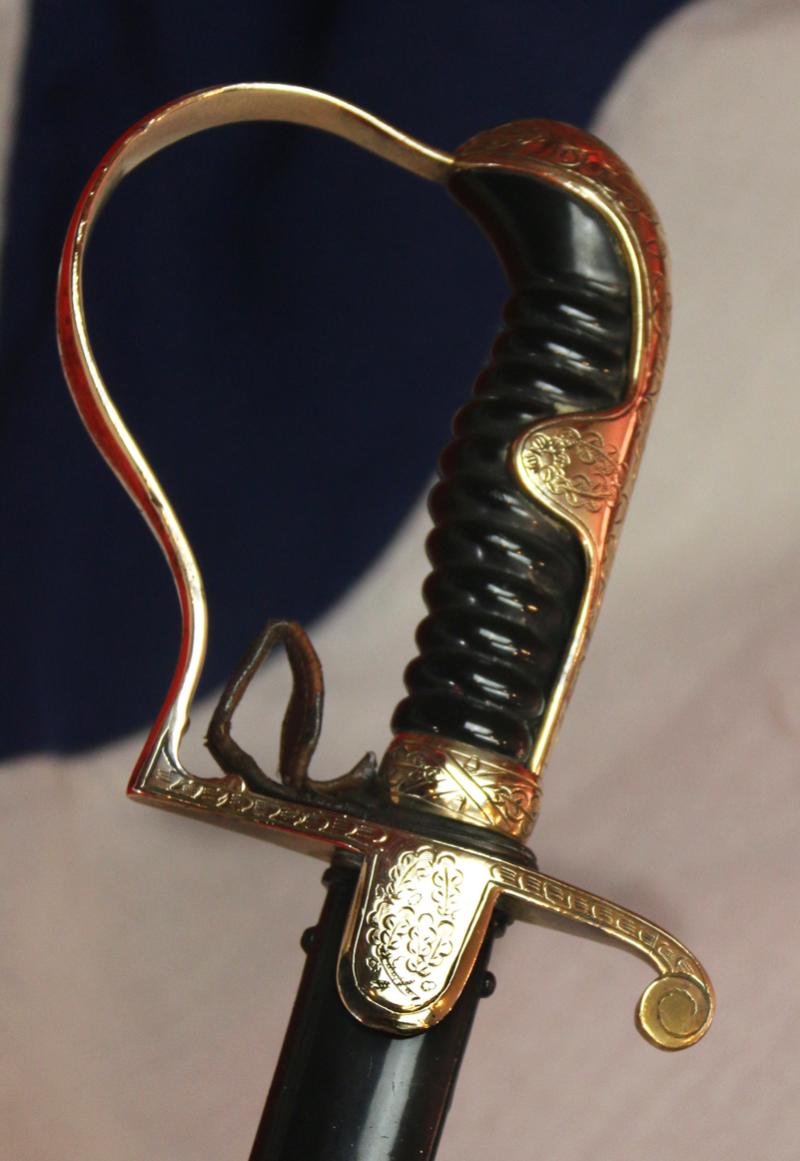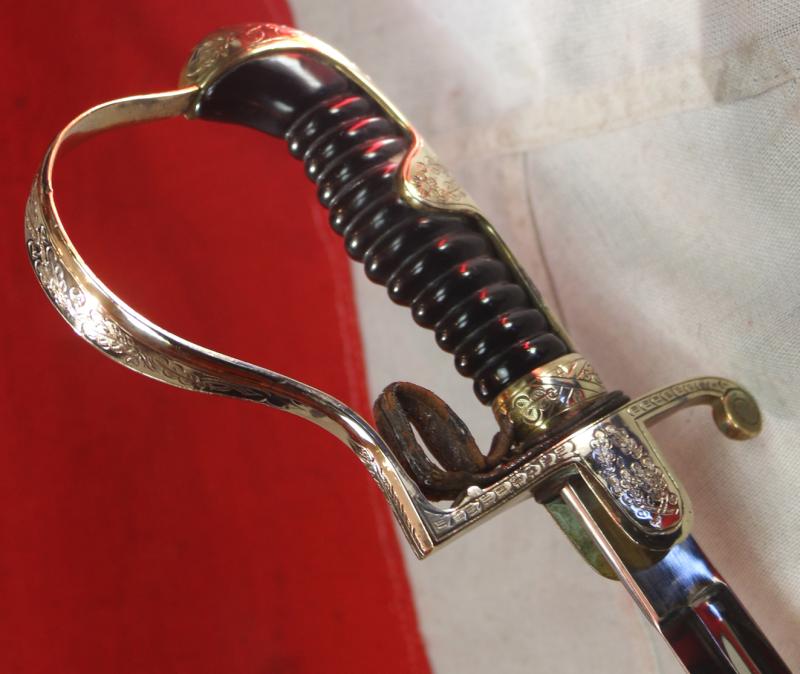A Singularly Beautiful German Officer's Dovehead Fully Deluxe Hand Engraved Sabre from the Weimar to the WW2 Third Reich Period. Hilt and Blade in Pristine Condition
By E.F.Horster Solingen.E. & F. Hörster (Solingen) is the last incarnation of the manufacturer “Friedrich Hörster”, later “F Hörster & Co.”. Its beginnings reach back to 1850. Friedrich Hörster died in 1875, at which point his son continued the family business as “E. & F. Hörster”, at the behest of Friedrich Emil & Fritz Hörster. The firm lasted after WWII.
This brass example is entirely engraved throughout. The pommel and backstrap area feature nicely done oak leaves and acorns having hand pebbling over the leaves and the veins all hand accented. The same is true of the oak leaves and acorns on the “P” guard. The grip tabs have two acorns which go around the rivet area. The crossguard has a series of box devices running throughout the length ending in a teardrop with an engraved swirl. The obverse langet features a Wehrmacht-style double oak leaf wreath. As with all of the above decoration this wreath is entirely hand carved into the brass. The ferrule above has a cross motif on the obverse and reverse with more oak leaves and acorns. The grip is a black celluloid over a carved wood base. The celluloid remains in perfect condition and is tightly wrapped with triple twisted brass wire. Much of the original polish still remains throughout the hilt of this piece – maybe 95% plus.
The scabbard is straight throughout. This scabbard has excellent original black paint. The paint is mostly all there showing nominal signs of usage but still in excellent condition. The long blade is in choice condition having its original high polish finish and retaining its needlelike tip. This blade is easily in full mint condition. The obverse ricasso is marked with the E&F Hörster double ovals. The ovals contain the firm’s name and the Solingen location. The center area features the large “H” letter with the smaller “H” and “S” letters that are pierced by a sword. The original brown leather washer is in place, and its original brown leather finger retaining loop. A very good, historical, early Army Officer’s sword More photos to add today
The German Army (German: Heer, was the land forces component of the Wehrmacht, the German armed forces, from 1935 to 1945. The Wehrmacht also included the Kriegsmarine (Navy) and the Luftwaffe (Air Force). During World War II, a total of about 15 million soldiers served in the German Army, of whom about seven million became casualties. Separate from the army, the Waffen-SS (Armed SS) was a multi-ethnic and multi-national military force of the Third Reich. Growing from three regiments to over 38 divisions during World War II, it served alongside the army but was never formally part of it.
Only 17 months after Hitler announced publicly the rearmament program, the Army reached its projected goal of 36 divisions. During the autumn of 1937, two more corps were formed. In 1938, four additional corps were formed with the inclusion of the five divisions of the Austrian Army after the Anschluss in March. During the period of its expansion by Adolf Hitler, the German Army continued to develop concepts pioneered during World War I, combining ground (Heer) and air (Luftwaffe) assets into combined arms teams. Coupled with operational and tactical methods such as encirclements and the "battle of annihilation", the German military managed quick victories in the two initial years of World War II, prompting the use of the word Blitzkrieg (literally lightning war, meaning lightning-fast war) for the techniques used.
The German Army entered the war with a majority of its infantry formations relying on the horse for transportation. The infantry remained foot soldiers throughout the war; artillery also remained primarily horse-drawn. The motorized formations received much attention in the world press in the opening years of the war, and were cited as the main reason for the success of the German invasions of Poland (September 1939), Norway and Denmark (April 1940), Belgium, France and Netherlands (May 1940), Yugoslavia (April 1941) and the early campaigns in the Soviet Union (June 1941). However their motorized and tank formations accounted for only 20% of the Heer's capacity at their peak strength.
Code: 25450




